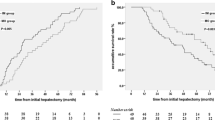Abstract
Background. Tumor recurrence is common after potentially curative ablation of hepatocellular carcinoma; therefore, the incidence of intrahepatic metastasis and multicentric carcinogenesis was evaluated. Methods. A cohort of 892 patients with cirrhosis caused by either hepatitis B virus (n = 246) or hepatitis C virus (n = 646) was followed up without interferon administration. Results. Hepatocellular carcinogenesis rates were 28.0% at the end of the fifth year, 49.2% at the tenth year, and 61.3% at the fifteenth year. Sex, hepatitis virus, alpha-fetoprotein, platelet count, age, and indocyanine green retention test value significantly affected the carcinogenesis rate. Of 372 patients with tumor development, 162 (43.5%) received surgical or radical locoregional therapy. On the assumption that a second carcinogenesis after sufficient ablation of well-differentiated cancer was attributable to multicentric carcinogenesis, recurrence rates after curative therapy in all the 162 patients, and the recurrence rates in 39 patients with solitary, small, and well-differentiated histology were analyzed: the rates were 58.2% and 30.9% at the third year, 75.9% and 53.4% at the fifth year, and 89.6% and 79.9% at the tenth year, respectively. The estimated incidence of multicentric recurrence was, therefore, 31% or higher at the third year and 53% or higher at the fifth year. The actual second carcinogenesis rates (multicentric recurrence) were approximately 1.6 times as high as those of the virtual second carcinogenesis rates calculated from statistical simulation. Conclusions. A longterm cohort study disclosed that multicentric carcinogenesis was the principal mechanism of recurrence after curative ablation of hepatocellular carcinoma and that the concept of “carcinogenic stage” should be introduced to improve the understanding of carcinogenic events in viral cirrhosis.
Similar content being viewed by others
Author information
Authors and Affiliations
Rights and permissions
About this article
Cite this article
Ikeda, K., Arase, Y., Kobayashi, M. et al. Significance of multicentric cancer recurrence after potentially curative ablation of hepatocellular carcinoma: a longterm cohort study of 892 patients with viral cirrhosis. J Gastroenterol 38, 865–876 (2003). https://doi.org/10.1007/s00535-003-1163-2
Received:
Accepted:
Issue Date:
DOI: https://doi.org/10.1007/s00535-003-1163-2




